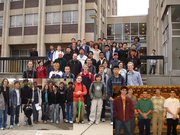06-240/Homework Assignment 10: Difference between revisions
No edit summary |
No edit summary |
||
| Line 1: | Line 1: | ||
{{06-240/Navigation}} |
{{06-240/Navigation}} |
||
{{ |
{{In Preparation}} |
||
'''Read''' sections 5.1, 5.2 and (back to the past!) 2.5 in our textbook. Remember that reading math isn't like reading a novel! If you read a novel and miss a few details most likely you'll still understand the novel. But if you miss a few details in a math text, often you'll miss everything that follows. So reading math takes reading and rereading and rerereading and a lot of thought about what you've read. |
'''Read''' sections 5.1, 5.2 and (back to the past!) 2.5 in our textbook. Remember that reading math isn't like reading a novel! If you read a novel and miss a few details most likely you'll still understand the novel. But if you miss a few details in a math text, often you'll miss everything that follows. So reading math takes reading and rereading and rerereading and a lot of thought about what you've read. |
||
Revision as of 20:31, 29 November 2006
| ||||||||||||||||||||||||||||||||||||||||||||||||||||||
The information below is preliminary and cannot be trusted! (v)
Read sections 5.1, 5.2 and (back to the past!) 2.5 in our textbook. Remember that reading math isn't like reading a novel! If you read a novel and miss a few details most likely you'll still understand the novel. But if you miss a few details in a math text, often you'll miss everything that follows. So reading math takes reading and rereading and rerereading and a lot of thought about what you've read.
Solve problems 1, 2, 3, 6, 7, 11, 14 and 17 on pages 256-259 but submit only your solutions of problems 3a, 3b, 11 and 17. This assignment is due at the tutorials on Thursday December 7.
Just for fun. A bit of history of determinants, which I learned from Wikipedia via Michael Dzamba:
- Historically, determinants were considered before matrices. Originally, a determinant was defined as a property of a system of linear equations. The determinant "determines" whether the system has a unique solution (which occurs precisely if the determinant is non-zero). In this sense, two-by-two determinants were considered by Cardano at the end of the 16th century and larger ones by Leibniz about 100 years later. Following him Cramer (1750) added to the theory, treating the subject in relation to sets of equations. The recurrent law was first announced by Bezout (1764).
